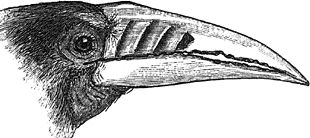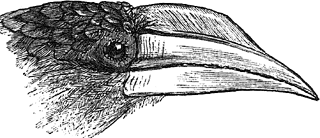|
Page 45 | prev page next page | |||||
|
Genus ACEROS, Hodgson, 1844 No true casque, but the basal portion of the upper mandible is thickened and crossed at the sides by dark oblique grooves not extending across the culmen, wanting in the young and increasing in number with age; cheeks, chin, and throat naked; tail long and graduated. Feathers of bead and neck loose-textured, both shafts and webs hair-like. Commissure of the bill greatly broken away in adults. Coloration of sexes different. A single species.
Fig. 43 - head of A. nepalensis Coloration: Male. head, neck, and lower parts rufous, darkest on the abdomen and flanks; end of middle primaries arid terminal half of tail white; remainder of plumage black, glossed with dark green; in the lower tail-coverts some chestnut is often mixed with the black. Female. Black, except the ends of the middle primaries and the terminal third of the tail, which are white. The young resemble adults of the same sex, except in wanting the ridges at the base of the upper mandible, these increase in number with age up to about seven. Bill yellow, the grooves chestnut; iris red; naked skin round eyes and at base of bill velvety light blue; naked skin of throat bright scarlet (Jerdon): feet dark brown (Hodgson). Size: Length 4 feet; tail 18 inches; wing 185; tarsus 2íS; bill from gape 8íS. Females are less: length 42 inches; tail 16; wing 17íS. Distribution: The Himalayas of Nepal, Sikkim, and farther east, from 2000 to about 6000 feet; the hills south of Assam, Karennee, and the Muleyit range in Tenasserim. Habits: Food, mode of flight, and nidification similar to those of other large Hornbills. This bird has a monosyllabic croak. A fall account of the nidification has been given by Mr. Gammie, who twice, both in April and in May, took a single egg from the hollow in a tree in which the female was enclosed in the usual manner. The number of eggs is said to be generally two. One egg measures 2.25 by 1.75, the other 2.12 by 1.57.
Casque small, compressed, sharp-edged, with the upper ridge parallel to the culmen, posteriorly curved downwards in front; both mandibles serrated on the commissure (serrations indistinct in young individuals) and much worn down in aged birds. Chin and throat naked. Crest well developed, its feathers of ordinary texture. Tail slightly rounded, not white at the end. Sexes alike. A single species.
Buceros galeritus, Temm. Fl. (lot. p.520 (1824); Blyth, Cat. p.44 Coloration: Head, neck, body above, and wings brownish black, glossed with green, becoming browner on the breast and abdomen and still paler round the vent and on the lower tail-coverts; basal two-thirds of tail-feathers brownish grey, terminal third black. Bill black; irides lake-red; gular and orbital skin pale blue; angle of gonvs, base of throat, and eyelids mottled white and black; legs and feet black. Young birds have the greater and median wing-coverts, secondary quills, and scapulars with pale buff edges to the outer webs, and the anterior part of the bill whitish yellow. Size: Length of male 33; tail 11; wing 14 tarsus 2; bill from gape 5.75. Females are smaller, wing 13í3. Distribution: The Malay peninsula, ranging into south Tenasserim as far north as Nwalabo mountain; also Sumatra and Borneo. Habits: Davison describes this Hornbill as a shy bird, keeping to high trees in forests, in parties of five or six, and never descending to the ground. The note resembles that of Anthracoceros coronatus and is uttered at short intervals.
Like Anorrhinus, but with the throat covered with feathers; tail more rounded; feathers of crest, throat and foreneck somewhat lax in texture; tail-feathers all tipped with white. There are two species, both peculiar, so far as is known, to British territory east of the Bay of Bengal.
Key to the Species Pti1ol tickelli, Tickellís Hornbill
Fig. 44 - head of P. tickelli Coloration: Male. Plumes at each side of forehead dull rufous; crown
and nuchal crest dark greyish brown, the feathers with whitish shaft-stripes and rufous edges; back, rump, upper tail coverts, scapulars, tertiaries, and
wing-coverts dark brown, larger secondary-coverts pale-edged, larger primary-coverts black, some of them white-tipped; primaries black, slightly
glossed, tipped white and with a broad buff outer border for an inch or two near the middle, but gradually nearer the tip in the later primaries;
secondaries black, outer web greyish brown and the margin buff; middle tail-feathers dark brown, other tail-feathers black glossed with green, all
tipped white, the outer more broadly; sides of neck and lower parts bright rufous, feathers of fore-neck with pale shaft-stripes; thigh-coverts mixed
with dusky; wing-lining dark brown, edge of wing in front of winglet buff. Bill and casque yellowish white in the male, the tip of the lower mandible blackish, and a saffron patch on each side of the base; bill and casque of female brownish black; irides in both sexes bright brown; skin around orbits and at base of lower mandible bluish white or blue; legs and feet brownish black. Size: Length of male 30; tail 11 wing 13; tarsus 2; bill from gape 5. The female is smaller: wing 12; bill 4 Distribution: Only known from the Tenasserim hills east of Moulmein. Habits: A shy restless bird, keeping to high forest, usually in parties of 8 or 10, and flying with the almost noiseless flight of Anthracoceros, alternately flapping and sailing. The nest has been described by Major Bingham, who found from 3 to 5 eggs in each of the usual nest-holes in February. The eggs are white originally, but generally stained during incubation, and average 0.82 by 1.34 in dimensions. These birds, according to Major Bingham, are far less wary in the breeding-season than at other times.
Size: Length about 31; tail 115; wing 12 tarsus 2; bill from gape 4í7 Distribution: The only specimen known for a long time was obtained by Colonel Godwin-Austen at Asalu, in the north Cachar hills; subsequently three more were shot by Hartert in the hill-forest south of the Dehing; this species was also observed by Hume in Manipur. Habits: Very little known. Hartert came upon a flock of 8 or 10, and far from being as shy as P. tickelli, they allowed him to fire six shots and kill four birds, one of which was left hanging in a high tree, before they flew away. Their flight was rather noisy. They had eaten a few insects (Mantides, Blatta, and locusts) besides fruit.
The only specie of this genus is distinguished by its very full crest of loose-textured, hair like feathers. This crest covers the crown; the feathers of the lores are similar and equally long, and are directed upwards and forwards. Bill large, curved, compressed; casque as in Anorrhinus, but small. Tail long, white, middle pair of feathers considerably exceeding the others.
Size: Length of adult male about 40; tail 18; wing 15; tarsus 2.5; bill from gape 7. Females a little less: wing 14, bill 5.75 Distribution: Malayan Peninsula, Sumatra, and Borneo, ranging into Southern Tenasserim as far as the base of Nwalabo, near Tavoy. Habits: According to Davison this Hornbill is found in forests about the lower trees and undergrowth; it lives in small parties, often feeding on the ground and eating lizards, &c., as well as fruit; the flight is uniform and almost noiseless; the call a peculiar cry (a mewing sound according to Hartert) repeated several times in quick succession.
|
| |||||
| prev page :: next page | ||||||
 birding.in | |||||||||
Hornbills - Fauna of India (Birds) 1895 by W. T. Blanford
All rights reserved. Copyright © 2005-2013 Birds and birding in India. Disclaimer website: Free Java Guide & Tutorials |

